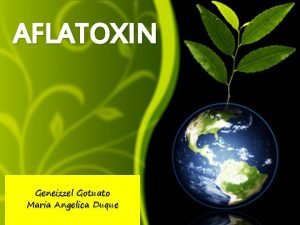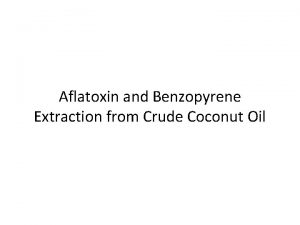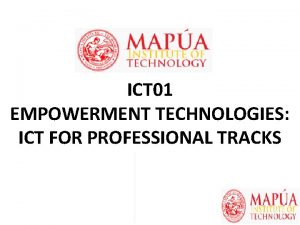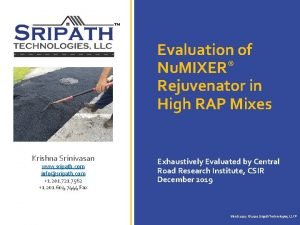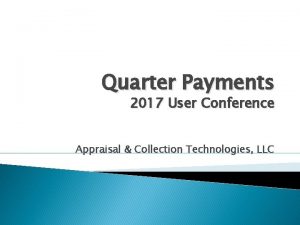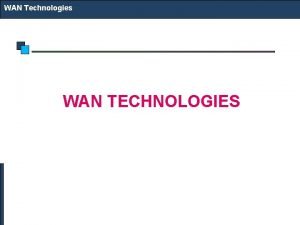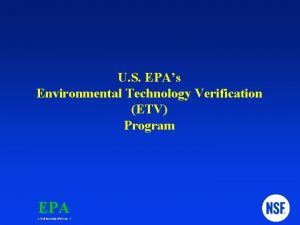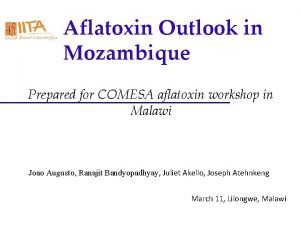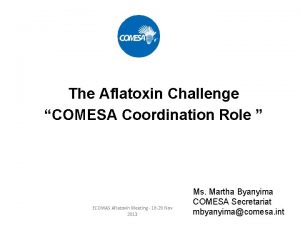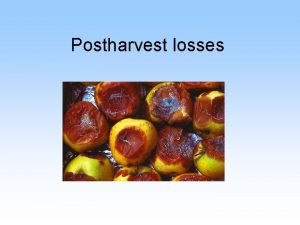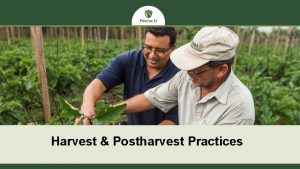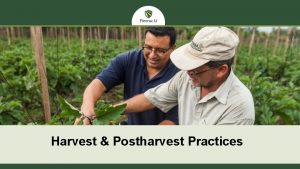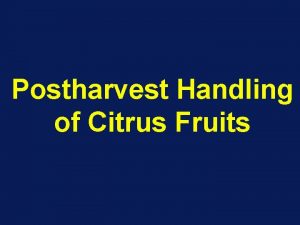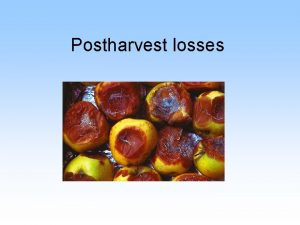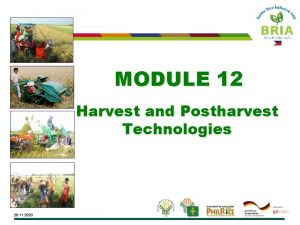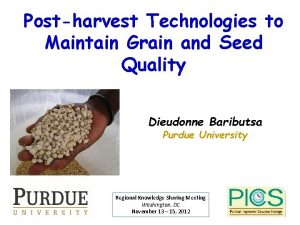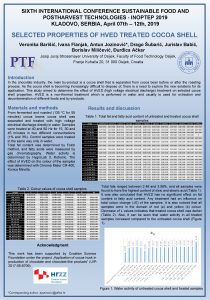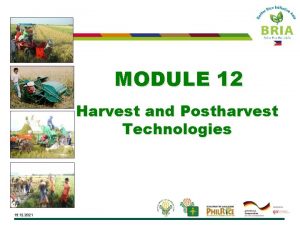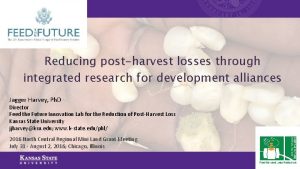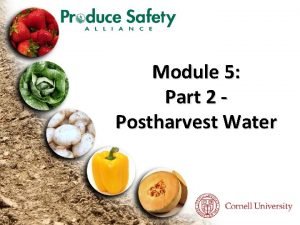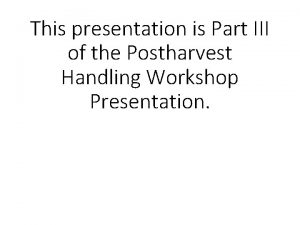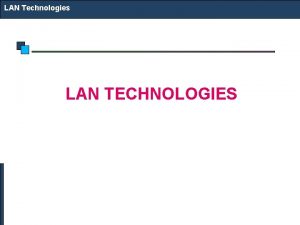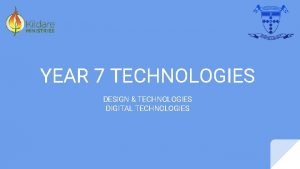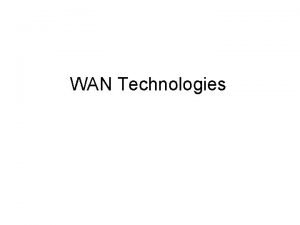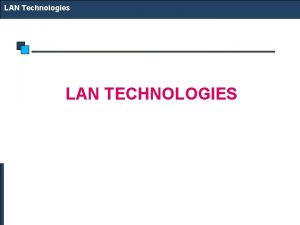Postharvest technologies as part of an integrated aflatoxin

































- Slides: 33

Postharvest technologies as part of an integrated aflatoxin reduction strategy Jagger Harvey, Ph. D Director Feed the Future Innovation Lab for the Reduction of Post-Harvest Loss Kansas State University jjharvey@ksu. edu; www. k-state. edu/phl/ Technology Assessments and Platforms: Tools and Reach in Africa 19 -21 July, 2016; Washington, D. C.

Post-harvest losses • Losses in quantity and quality, including economic losses. • Estimated ~1/3 loss, often more in developing countries • Limited focus on gender – key for development • Limited success and impact to date relative to • Tremendous promise to address food security Mycotoxins: • Scant evidence base – weak methodologies • Many interventions available, off the shelf or used elsewhere

Mycotoxins • Compounds produced by a range of fungi, toxic to human health • Contaminate crops broadly • Carry over into animal-sourced foods Photo: Karanja, KALRO

Aflatoxin • • Produced by Aspergillus fungi Infect a range of crops Invisible/difficult to detect or sort Toxic to humans and animals (livestock) – Carcinogenic – Associated with • Stunting • Immunosuppression • Blocking nutrient absorption


2010 outbreak: Eastern Kenya posho mill maize survey Samuel Mutiga (Rebecca Nelson, Cornell) Mutiga et al. , 2014 Phytopathology 104(11): 1221 -1231 (Cornell/UMd/Bec. A-ILRI Hub)

2010 outbreak: Eastern Kenya posho mill maize survey 39% >LL aflatoxin (up to 60% by district) 37% >LL fumonisin Samuel Mutiga (Rebecca Nelson, Cornell) Mutiga et al. , 2014 Phytopathology 104(11): 1221 -1231 (Cornell/UMd/Bec. A-ILRI Hub)

Aflatoxin risk: a complex set of drivers Aflatoxin risk determined by: Host: crop species and variety/type x Fungal population x Crop management in field x Environmental conditions x Postharvest practices

A broad and expanding threat

A broad and expanding threat

Addressing a complex problem To reduce aflatoxins for all farmers and consumers, reducing risk and addressing contamination along the value chain is essential. Targeting appropriate interventions: Prevention – reduce risk from field to consumption Surveillance and response – when conditions have eclipsed interventions’ effective range

Convergent wins: leveraging ongoing efforts, adoption incentives Broad set of ongoing productivity and postharvest programs. • Incentives for adoption • Maximizing outcomes from ongoing ag devt landscape

Integrating interventions Preharvest: Biocontrol: competitive exclusion – under expanding deployment Good agricultural practices: adoption incentive includes higher yield • Reduce biotic and abiotic crop stress (e. g. , drought, nutrient stress) • Use appropriate varieties for agroecologies • Planting time • Intercropping, crop rotation, tillage, fertilizer • Planting less susceptible crops Periharvest: harvest time, avoid soil contact Postharvest: adoption incentive includes reduce losses • Testing decontamination and alternative uses • Proper drying Moisture content (measurement) • Proper storage • Testing decontamination and alternative uses (Surveillance to predict hotspots near harvest time: modelling and mobile diagnostics - appropriate sampling)

Technologies approaching deployment Preventative • Anti-fungal plant extracts (Temba et al. , cucurmin) • Adapted drying technologies (eg, SBHD in Ghana) • Adapted storage technologies (eg, plastic silos) • Monitoring storage conditions: EMC moisture meter Surveillance and response • Diagnostics and testing • Alternative use, decontamination

Entry points Smallholder farmers Aggregators Processors Consumers – awareness to drive demand

Towards integration of mycotoxin reduction strategies

Empowering NARS as leaders in the process



Post-Harvest technologies to reduce aflatoxin risk






Ft. F Innovation Lab: Post-Harvest Loss Technical focus areas: -drying -storage -insect pests, mycotoxins Cross-cutting: -capacity building (universities, government; lab, curriculum, extension, …) -nutrition -gender

Ft. F Innovation Lab: Post-Harvest Loss Afghanistan Tree nuts, raisins, wheat Guatemala Maize Ghana Maize Bangladesh Rice Ethiopia Chickpea, maize, sesame, wheat

Integrating approaches Success 1: novel/adapted drying technologies Success 2: adapted storage technologies Success 3: low cost moisture meter Additional considerations: e. g. , Pathway to impact (actors, …), Women’s Empowerment in Agriculture Index

Integrating approaches: Bangladesh STR Dryer USDA-ARS PHLIL Moisture Meter Improved (vs. traditional) storage

Integrating approaches: Ghana USDA-ARS PHLIL Moisture Meter Solar biomass hybrid dryer Adapted storage technologies

Emerging technologies: road ahead

Technologies approaching deployment Preventative • Anti-fungal plant extracts (Temba et al. , cucurmin) • Adapted drying technologies (eg, SBHD in Ghana) • Adapted storage technologies (eg, plastic silos) • Monitoring storage conditions: EMC moisture meter Surveillance and response • Diagnostics and testing • Alternative use, decontamination

Acknowledgements Feed the Future – USAID Technology Assessments and Platforms organizers; Gabrielle Persley, Kerri Wright Platais PHLIL team members (full set of partners at www. k-state. edu/phl/) Afghanistan: John Leslie (Kansas State University) and collaborators, Ministry of Agriculture, Irrigation and Livestock Bangladesh: Prasanta Kalita (University of Illinois at Urbana-Champaign; Director, ADM Institute for Post. Harvest Loss), Monjurul Alam (Bangladesh Agriculture University) and collaborators Ethiopia: Subramanyam Bhadriraju (Kansas State University) and collaborators Ghana: George Opit (Oklahoma State University) and collaborators Guatemala: Carlos Campabadal (Kansas State University) and collaborators Moisture meter: Paul Armstrong, USDA-ARS, Kansas State University Bec. A-ILRI Hub Australian Government
 Aflatoxin
Aflatoxin Angelica duque
Angelica duque Aflatoxin coconut oil
Aflatoxin coconut oil Bryant integrated technologies
Bryant integrated technologies Integrated wireless technologies
Integrated wireless technologies Part to part ratio definition
Part to part ratio definition The phase of the moon you see depends on ______.
The phase of the moon you see depends on ______. Part part whole
Part part whole Part to part variation
Part to part variation Technical object description example
Technical object description example Addition symbol
Addition symbol Footed ware
Footed ware Howard pickard
Howard pickard Ezteller
Ezteller Professional tracks example
Professional tracks example Sripath technologies
Sripath technologies Jet global data technologies
Jet global data technologies Bossa nova vision
Bossa nova vision National 5 fashion and textiles
National 5 fashion and textiles Sirena technologies
Sirena technologies Zlti
Zlti Suzhou goldengreen technologies ltd
Suzhou goldengreen technologies ltd Dss systems and software technologies pvt. ltd.
Dss systems and software technologies pvt. ltd. Egras
Egras Emergent game technologies
Emergent game technologies Flashback technologies
Flashback technologies Rectifier technologies australia
Rectifier technologies australia Haycom technologies
Haycom technologies Appraisal & collection technologies
Appraisal & collection technologies Maven vista technologies pvt ltd
Maven vista technologies pvt ltd Wan connection technologies
Wan connection technologies Epas technologies
Epas technologies Brett hannath
Brett hannath Gsn technologies
Gsn technologies

